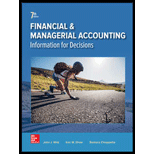
1.
To compute: Annual expected net
1.
Explanation of Solution
Given below is the table for the computation of annual expected net cash flows:
| Particulars | Project A ($) | Project B ($) |
| Net income | 39,900 | 25,900 |
| 60,000 | 80,000 | |
| Net cash flows | 99,900 | 105,900 |
Working note:
Calculation of annual depreciation of Project A,
Calculation of annual depreciation of Project B,
Hence, cash flow after tax is from project A is $99,900 and Project B is $105,900.
2.
To compute: Payback period.
2.
Explanation of Solution
Computation of payback period for project A:
Given,
Cost of investment of Project A is $240,000.
Annual net cash flow from Project A is $99,900.
Formula to calculate payback period,
Substitute $240,000 for initial investment and $99,900 for net annual
Computation of payback period for project B:
Given,
Cost of investment of Project B is $240,000.
Annual net cash flow from Project B is $105,900.
Formula to calculate payback period,
Substitute $240,000 for initial investment and $105,900 for net annual cash inflow.
Hence, payback period of project A is 2.40 years and Project B is 2.27 years.
3.
To compute: Accounting
3.
Explanation of Solution
Computation of accounting rate of return (ARR) for Project A:
Given,
Average annual profit of Project A is $39,900.
Average investment in Project A is $120,000.
Formula to calculate of accounting rate of return,
Substitute $39,900 for average annual profit and $120,000 for average investment.
Computation of accounting rate of return (ARR) for Project B:
Given,
Average annual profit of Project B is $25,900.
Average investment in Project B is $120,000.
Formula to calculate of accounting rate of return,
Substitute $25,900 for average annual profit and $120,000 for average investment.
Working note:
Calculation of average investment of Project A,
Calculation of average investment of Project B,
Hence, ARR for project A is 33.25% and Project B is 21.58%.
4.
To compute:
4.
Explanation of Solution
Computation of Net present value (NPV) for Project A:
Given,
Annual net cash flows from Project A is $199,900.
Cost of investment is $240,000.
Market interest rate is 8%.
Number of periods is 4 years.
Present value factor for cumulative 4 years is 3.3121.
Formula to calculate NPV,
Substitute $330,879 for the present value of cash flows and $240,000 for the cost of investment.
Computation of Net present value (NPV) for Project B:
Given,
Annual net cash flow from Project B is $105,900.
Cost of investment is $240,000.
Market interest rate is 8%.
Number of periods is 3 years.
Present value factor for cumulative 3 years is 2.5771.
Formula to calculate NPV,
Substitute $272,915 for the present value of cash flows and $240,000 for the cost of investment.
Working notes:
Formula to calculate present value of cash flows of Project A,
Formula to calculate present value of cash flows of Project B,
Hence, NPV for project A is $90,879 and Project B is $32,915.
5.
To identify: Recommendation to management to pursue Project A.
5.
Explanation of Solution
Hence, it is recommended to management to pursue Project A.
Want to see more full solutions like this?
Chapter 24 Solutions
GEN COMBO LOOSELEAF FINANCIAL AND MANAGERIAL ACCOUNTING; CONNECT ACCESS CARD
- The actual cost of direct labor per hour is $16.25 and the standard cost of direct labor per hour is $15.00. The direct labor hours allowed per finished unit is 0.60 hours. During the current period, 4,500 units of finished goods were produced using 2,900 direct labor hours. How much is the direct labor rate variance? A. $3,625 favorable B. $3,625 unfavorable C. $4,350 favorable D. $4,350 unfavorablearrow_forwardOn January 1 of the current year, Piper Company issues a 4-year, non-interest-bearing note with a face value of $8,000 and receives $4,952 in exchange. The recording of the issuance of the note includes a: a. credit to Notes Payable for $4,952. b. credit to Discount on Notes Payable for $3,048. c. debit to Discount on Notes Payable for $3,048. d. debit to Cash for $8,000.arrow_forwardPLease helparrow_forward
- What is the budgeted total cost of direct materials purchases?arrow_forwardHy expert provide answer with calculationarrow_forwardDuring September, the assembly department completed 10,500 units of a product that had a standard materials cost of 3.0 square feet per unit at $2.40 per square foot. The actual materials purchased consisted of 22,000 square feet at $2.60 per square foot, for a total cost of $57,200. The actual material used during this period was 25,500 square feet. Compute the materials price variance and materials usage variance.arrow_forward
- Bluesy Electronics recorded the following financial data: Net Sales $720,500 Average Inventory at Cost = $80,200 Gross Margin Percentage = 42% Calculate the GMROI.arrow_forwardNeed help this question solutionarrow_forwardXYZ Company has a gross profit margin of 0.30, an operating profit margin of 18%, a total asset turnover ratio of 2.0x, and cost of goods sold of $700,000. The company's tax rate is 35%, and it has no debt. Calculate XYZ Company's Return on Assets (ROA).arrow_forward

 AccountingAccountingISBN:9781337272094Author:WARREN, Carl S., Reeve, James M., Duchac, Jonathan E.Publisher:Cengage Learning,
AccountingAccountingISBN:9781337272094Author:WARREN, Carl S., Reeve, James M., Duchac, Jonathan E.Publisher:Cengage Learning, Accounting Information SystemsAccountingISBN:9781337619202Author:Hall, James A.Publisher:Cengage Learning,
Accounting Information SystemsAccountingISBN:9781337619202Author:Hall, James A.Publisher:Cengage Learning, Horngren's Cost Accounting: A Managerial Emphasis...AccountingISBN:9780134475585Author:Srikant M. Datar, Madhav V. RajanPublisher:PEARSON
Horngren's Cost Accounting: A Managerial Emphasis...AccountingISBN:9780134475585Author:Srikant M. Datar, Madhav V. RajanPublisher:PEARSON Intermediate AccountingAccountingISBN:9781259722660Author:J. David Spiceland, Mark W. Nelson, Wayne M ThomasPublisher:McGraw-Hill Education
Intermediate AccountingAccountingISBN:9781259722660Author:J. David Spiceland, Mark W. Nelson, Wayne M ThomasPublisher:McGraw-Hill Education Financial and Managerial AccountingAccountingISBN:9781259726705Author:John J Wild, Ken W. Shaw, Barbara Chiappetta Fundamental Accounting PrinciplesPublisher:McGraw-Hill Education
Financial and Managerial AccountingAccountingISBN:9781259726705Author:John J Wild, Ken W. Shaw, Barbara Chiappetta Fundamental Accounting PrinciplesPublisher:McGraw-Hill Education





